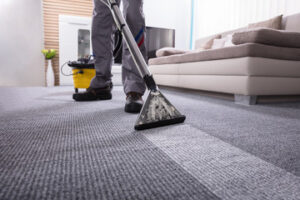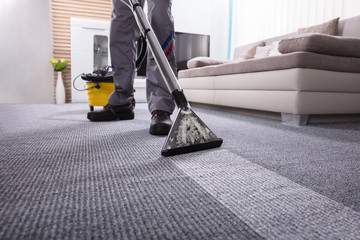Carpets act as filters, trapping airborne pollutants like dust, dander, and mold spores inside their fibers. Vacuuming alone doesn’t get rid of all these toxins.
The first step in Residential Carpet Cleaning El Dorado Hills CA is pre-conditioning with a shampoo that helps liquefy oil and soil. Then a hot water extraction machine sucks up the shampoo, dirt, and any other contaminants.
When dirt gets ground into carpet fibers, it causes abrasion and wear, leaving the carpet more vulnerable to stains. While vacuuming and steam cleaning will remove some of the dirt, they will not remove the deep dirt that clings to the carpet fibers. If you want your carpet to stay as clean as possible, it is important to remove dirt regularly.
Regular sweeping and use of a broom with a stiff-bristled brush will help keep dirt from building up in your carpet. Vacuuming is also essential to removing loose dirt and dust from the carpet, and you should use the beater bar when vacuuming to agitate the rug and lift up any deep dirt trapped in the fibers.
To get rid of stubborn dirt, mix a solution of one teaspoon of mild dishwashing detergent to a cup of lukewarm water. Dip a white cloth in this solution and blot the affected area of the carpet. Repeat this process until the stain is lifted. This will help you avoid rubbing the stain further into the carpet, which could make it more difficult to remove.
Another method for removing dirt is to apply baking soda and scrub with a brush. If you do not have a brush, you can use old towels or rags. Be sure to scrub the carpet in a grid pattern so that you do not miss any areas. Once the dirt is loosened, you can blot it away with a damp cloth.
You can also use shaving cream to remove stubborn stains from carpet. This will break down protein, which is the main component of food and beverage stains, and it can also break down oil, which will help to remove grease and tar stains. When using a shaving cream, be sure to test it in an inconspicuous area before applying it to the entire carpet.
When you are done scrubbing the stained area, rinse with warm water and blot dry. To speed up drying time, you can open windows or use fans to blow air over the carpet. It is also important to not re-arrange furniture until the carpet is fully dry. This will minimize marks and varnish stains from rearranging the furniture and will prevent pets and children from stepping on freshly cleaned carpets while it is still damp.
Stains
Stains can be challenging to remove from carpets. It is important to pretreat and treat stains as soon as they occur so that the stain can be removed without it being absorbed into deeper layers of the fibers where it could become permanent. This also gives you a better chance of preventing the stains from recurring.
If you have a water-soluble stain, such as wine or coffee, start by blotting — never rubbing — with a color-safe cloth to absorb as much of the liquid as possible. Next, use a solution of equal parts water and vinegar to spray the stain. After spraying, blot again with a clean white cloth. Repeat as needed to get as much of the stain out as possible. If the stain persists, a professional may be necessary.
Protein-based stains, like blood or dairy products, can be especially stubborn and difficult to remove from carpets. These types of stains are unique because they react to heat and acid, which can make them darker and more adhesive to the carpet fibers. If you have protein-based stains, it is recommended that you use a small amount of ammonia diluted with cold water to treat the spot.
Tannin stains, such as those from tea or wine, are also water-soluble and can be difficult to remove from carpets. If you have a tannin stain, start by blotting with a color-safe cloth or paper towel to absorb as much of the stain as possible. Next, mix hydrogen peroxide and baking soda to apply over the stain. Let the mixture sit for a few minutes before blotting it again with a white cloth. Once you’ve gotten as much of the stain out as possible, vacuum the area.
If you have a pet, you’ll likely need to treat their urine stains and odors more frequently than other types of stains because these stains are very difficult to remove from carpeting. First, blot the problem area with a cloth that is color-safe (one that does not have any prints or patterns on it) to absorb as much of the urine as possible. Then, blot with a cleaning solution formulated specifically for treating pet stains and odors.
Dust
Whether it’s from outside or inside, dust accumulates quickly in carpeted areas. It’s a reservoir for microbes, including germs like bacteria and fungi, as well as for chemicals from cleaning products and other household items. Dust can also contain legacy pollutants, such as lead from paint and gasoline and now-banned polychlorinated biphenyls (PCBs). These compounds linger in house dust for years, even after the original contaminants are removed.
In addition to being an eyesore, dust can trigger allergies and asthma. It can also contribute to stale indoor air and the growth of mold, mites and mildew. A regular carpet cleaning routine is an essential part of keeping dirt and allergens under control.
Vacuuming is the best way to remove surface-level dirt and debris from a carpeted area. However, it can be a challenge to clean the deeper layers of accumulated dust. First, it’s important to vacuum the entire room to prevent missing any spots or corners. Then, take the time to use a cranny extension or other vacuum attachments to get in and around furniture to eliminate hidden dust bunnies and other debris.
To keep your carpets looking great, avoid harsh cleaners that can damage the fibers or cause them to resoil quickly. Instead, opt for SOA-certified products that clean effectively and maintain carpet life and warranty protection.
Periodic deep cleaning is also recommended to remove embedded dirt and allergens. This intense cleaning process restores a carpet’s appearance, bringing back the bounce in its fibers and brightness in its colors.
Other important strategies for minimizing the buildup of dust include placing doormats at all entrances to trap external dirt and moisture, removing shoes when entering a home or apartment, and regularly washing places where dead skin particles often accumulate (sheets, blankets, pillows, etc). Additionally, replacing carpet with hard surfaces can greatly reduce the amount of dust that builds up and contributes to indoor air pollution.
Pets
Carpet cleaning companies use high-powered machines designed to forcefully flush out dirt particles, odors and residue from the fibers of carpeting. These machines vary in size from those used in residential homes to large ones that are hooked up to truck-mounted hoses. The cleaning solution is mixed in a tank on the machine and is dispensed onto carpets in controlled amounts. The vacuuming machine then extracts the dirty water and waste, leaving the carpet clean and fresh. Many carpet cleaners also offer add-on treatments, such as soil retardants and deodorants, but these vary in price from company to company and may not be safe for all dyed fibers.
Pet stains and odors can be difficult to remove from carpeting, especially if they’re old and set in. Vacuuming regularly helps to keep these stains at bay, as does brushing pets with a good quality de-shedding tool to help reduce the amount of hair that is shed in the first place. If a stain or odor is still apparent, try rubbing the area with a clean damp sponge to help break up the stain and then blotting it with a cloth that is slightly wet. This will help to lift the stains and odors out of the carpet fibers without causing further damage.
Commercial and residential carpeting both need regular care to prolong their life and keep them looking great. In the case of commercial properties, these care procedures are generally more frequent than in residential homes because of the heavy traffic that they experience daily. Commercial carpets are usually darker in color than home carpeting, so they tend to show more dirt and stains than their lighter counterparts.
Often, the best way to keep up with a business’s carpeting needs is by scheduling regular cleanings with a professional. Before allowing any company to begin work, be sure that they understand your concerns and expectations. Ask them to be sure that they are using a method that is safe for your carpet, such as hot-water extraction, and be sure that they are not selling add-on services that are not needed.
